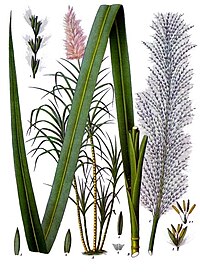
Photo from wikipedia
Sugarcane bagasses from three experimental sugarcane hybrids and a mill‐reference sample were used to compare the efficiency and mode of action of acid and alkaline sulfite pretreatment processes. Varied chemical… Click to show full abstract
Sugarcane bagasses from three experimental sugarcane hybrids and a mill‐reference sample were used to compare the efficiency and mode of action of acid and alkaline sulfite pretreatment processes. Varied chemical loads and reaction temperatures were used to prepare samples with distinguished characteristics regarding xylan and lignin removals, as well as sulfonation levels of residual lignins. The pretreatment with low sulfite loads (5%) under acidic conditions (pH 2) provided maximum glucose yield of 70% during enzymatic hydrolysis with cellulases (10 FPU/g) and β‐glucosidases (20 UI/g bagasse). In this case, glucan enzymatic conversion from pretreated materials was mostly associated with extensive xylan removal (70–100%) and partial delignification occurred during the pretreatment. The use of low sulfite loads under acidic conditions required pretreatment temperatures of 160°C. In contrast, at a lower pretreatment temperature (120°C), alkaline sulfite process achieved similar glucan digestibility, but required a higher sulfite load (7.5%). Residual xylans from acid pretreated materials were almost completely hydrolysed by commercial enzymes, contrasting with relatively lower xylan to xylose conversions observed in alkaline pretreated samples. Efficient xylan removal during acid sulfite pretreatment and during enzymatic digestion can be useful to enhance glucan accessibility and digestibility by cellulases. Alkaline sulfite process also provided substrates with high glucan digestibility, mainly associated with delignification and sulfonation of residual lignins. The results demonstrate that temperature, pH, and sulfite can be combined for reducing lignocellulose recalcitrance and achieve similar glucan conversion rates in the alkaline and acid sulfite pretreated bagasses. © 2018 American Institute of Chemical Engineers Biotechnol. Prog., 34:944–951, 2018
Journal Title: Biotechnology Progress
Year Published: 2018
Link to full text (if available)
Share on Social Media: Sign Up to like & get
recommendations!